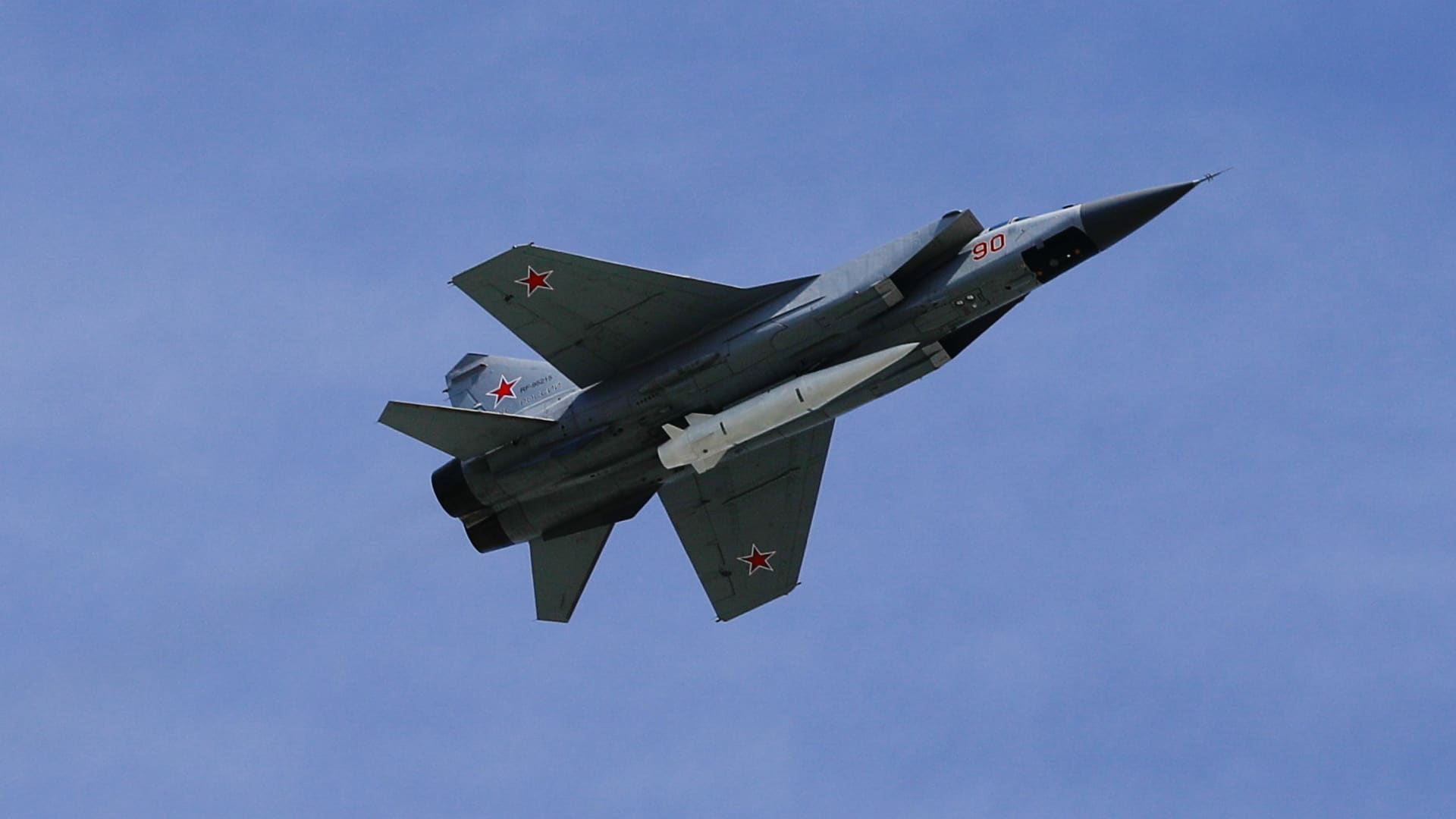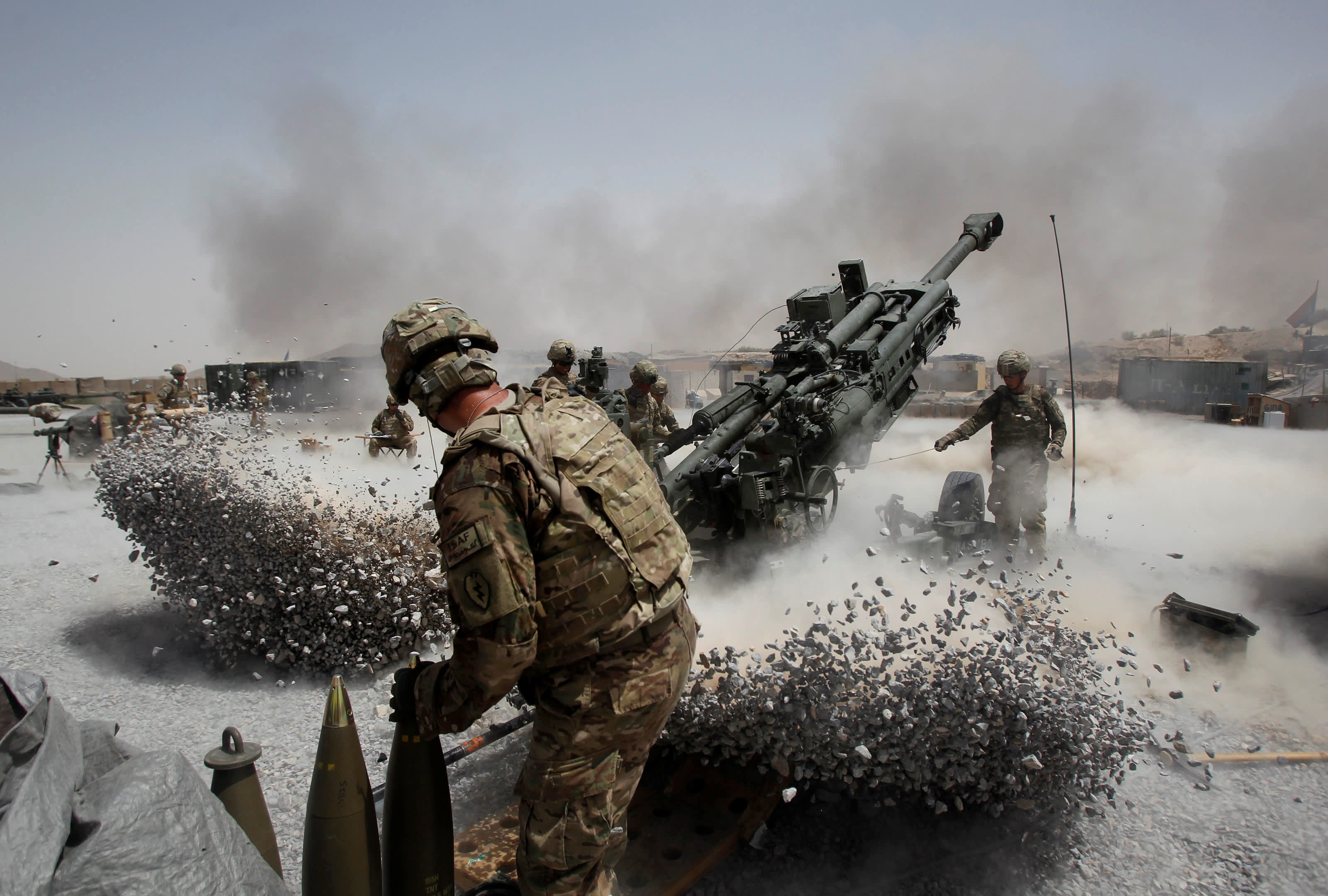Russia says it fired hypersonic missiles in Ukraine. What are they and why would Moscow use them?
Russia's Defense Ministry said last week it had deployed "Kinzhal" (meaning "Dagger" in Russian) hypersonic aeroballistic missiles.

A MiG-31K fighter jet with a Kinzhal hypersonic missile flies over Moscow's Red Square during the Victory Day military parade in 2018.
Sefa Karacan | Anadolu Agency | Getty Images
Russia's purported use of hypersonic missiles in Ukraine in recent days is not only a sign that its military could be resorting to using more destructive weaponry, but also an opportunity for Russia to flaunt weapons it says it's been developing for several years.
Russia's Defense Ministry said Friday that it had deployed "Kinzhal" (meaning "Dagger" in Russian) hypersonic aeroballistic missiles to destroy a large underground warehouse of Ukrainian missiles and aviation ammunition in Delyatin, in the Ivano-Frankivsk region of western Ukraine.
Then on Saturday, the ministry said it had used Kinzhal hypersonic aeroballistic missiles again to destroy a large Ukrainian storage base for fuels and lubricants in the Mykolaiv region. Russia's Defense Ministry said in a statement it was the main fuel supply base for Ukrainian armored vehicles in combat areas in southern Ukraine.
Russian news agencies said the reported use of hypersonic missiles was the first time the country's military had used them in its invasion of Ukraine, which began Feb.24.
CNBC was unable to immediately verify the claims of hypersonic weapon use. The Pentagon said it wasn't able to either, but Russia has been flaunting the development of several types of hypersonic weapons for several years.
CNBC has a brief guide to hypersonic missiles and what Russia claims to have used:
What is a hypersonic missile?
In 2018, during his State of the Nation address, President Vladimir Putin bragged about Russia's development of hypersonic missiles as he unveiled the Kinzhal and several other next-generation strategic weapons. Putin said at the time Russia had developed a new prototype missile that "can reach any point in the world" and a supersonic weapon that cannot be tracked by anti-missile systems.
The Center for Strategic and International Studies think tank noted in a February report that "hypersonic weapons combine the speed and range of ballistic missiles with the low-altitude and maneuverable flight profile of a cruise missile."
What is the Kinzhal hypersonic missile?
The Kh-47M2 Kinzhal hypersonic missile is an aeroballistic air-to-surface missile that Russia claims has a range of more than 2,000 kilometers, or 1,200 miles, and a speed of Mach 10 — that is, that they can travel 10 times faster than the speed of sound.
The Kinzhal hypersonic missile is designed to be carried by MiG fighter jets, as seen in the image below, which shows MiG-31K supersonic interceptor aircraft designed to carry Kh-47M2 Kinzhal missiles.
Russia's MiG-31 supersonic interceptor jets carrying hypersonic Kinzhal missiles fly over Red Square during the Victory Day military parade in Moscow on May 9, 2018.
Yuri Kadobnov | AFP | Getty Images
Russian news agency Interfax cited the Russian military as suggesting that such missiles could be guaranteed to overcome all existing and developed air and missile defense systems.
Putin has made such remarks himself, saying in 2018 that these kinds of weapons provide "substantial advantages in an armed conflict." He added that "its speed makes it invulnerable to current missile and air defense systems, since interceptor missiles are, simply put, not fast enough."
"In this regard, it is quite understandable why the leading armies of the world seek to possess such an ideal weapon," Putin said.
Russia has heavily invested in developing hypersonic weapons in recent years, with Putin also announcing in 2018 the development of the "impossible to intercept" Avangard hypersonic glide vehicle which has a range of more than 6,000 km, and the Zircon hypersonic cruise missile, as well as the Dagger.
Should we be worried?
Russia's Defense Ministry on Saturday released a video via Twitter that it claimed showed the missile strike on the arms depot. NBC News was unable to verify the claim, or when or where the explosion in the footage occurred, however.
The Pentagon said it could not refute or independently confirm their use in the strike.
A senior U.S. Defense official, who spoke on the condition of anonymity in order to share new details from the Pentagon's ongoing assessment of the war, said it would be odd for the Kremlin to fire a hypersonic weapon.
"It's a bit of a head-scratcher. ... Why you would need a hypersonic missile fired from not that far away to hit a building?" the official said. Since Russia's Feb. 24 invasion of its ex-Soviet neighbor, the Pentagon has observed more than 1,100 Russian missile launches into Ukraine.
James Bosbotinis, a U.K.-based specialist in defense and international affairs, said on Twitter that "Russia's reported use of a hypersonic air-launched Kinzhal against Ukraine is unsurprising," adding it would act as both "a signal to Ukraine that Russia has options to escalate, and a message to NATO."
The Kinzhal is Russia's first operational conventionally armed hypersonic weapon, Bosbotinis added, but U.S. Defense Secretary Lloyd Austin said on Sunday he didn't see the use of hypersonic missiles in Ukraine "as a game changer."
"I think the reason he is resorting to using these types of weapons is because he is trying to reestablish some momentum," Austin told the CBS program "Face the Nation."
Nonetheless, hypersonic missiles pose new dilemmas for national defense bodies and complex air defense around the world.
The Center for Strategic and International Studies said in its February report that "defending against hypersonic missiles is strategically necessary, technologically possible, and fiscally affordable, but it will not be easy."
"While traditional defenses can handle these challenges individually, their combination will require new capabilities, operational concepts, and defense design. The same characteristics that make hypersonic missiles attractive may also hold the key to defeating them. Instead of thinking about hypersonic defense as an adjunct to the legacy ballistic missile defense problem, it might be better understood as a form of complex air defense."
— CNBC's Amanda Macias contributed reporting to this story.

 Astrong
Astrong 
































